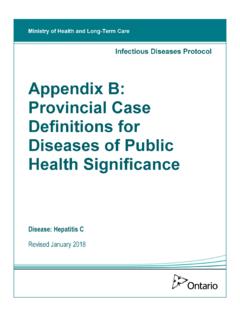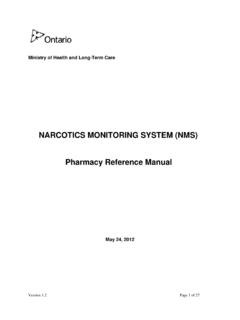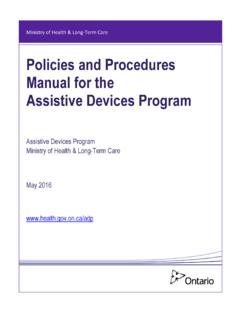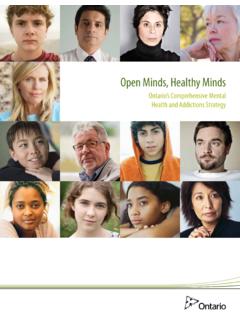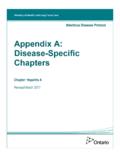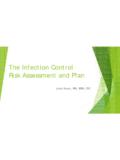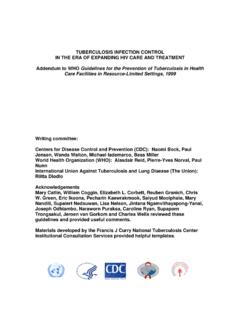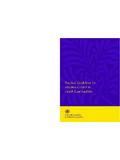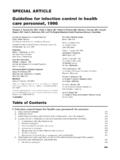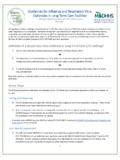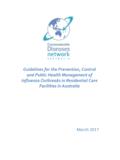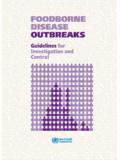Transcription of Appendix A: Disease-Specific Chapters
1 Ministry of Health and Long-Term Care Infectious Diseases Protocol Appendix A: Disease-Specific Chapters chapter : respiratory Infection Outbreaks in Institutions and Public Hospitals Effective: May 2018 Health and Long-Term Care 2 respiratory Infection Outbreaks in Institutions and Public Hospitals Communicable Virulent Health Protection and Promotion Act: O. Reg. 135/18 (Designation of Diseases) Aetiologic Agent respiratory infection outbreaks in institutions and public hospitals are caused by a variety of respiratory viruses such as influenza A and B, respiratory syncytial virus (RSV), parainfluenza, rhinovirus, human metapneumovirus, coronaviruses and adenovirus. Bacteria that occasionally cause respiratory outbreaks in institutions are Chlamydophila pneumoniae, Legionella spp.
2 And Mycoplasma pneumoniae (Atypical Pneumonia). Case Definition Surveillance Case Definition See Appendix B outbreak Case Definition The outbreak case definitions are established to reflect the disease and circumstances of the outbreak under investigation. The outbreak case definitions should be developed for each individual outbreak based on its characteristics, reviewed during the course of the outbreak , and modified if necessary, to ensure that the majority of cases are captured by the definition. The case definitions should be created in consideration of the outbreak definitions. Consideration should also be given to the following when establishing outbreak case definitions: Clinical and/or epidemiological criteria; The time frame for occurrence ( , increase in endemic rate); A geographic location(s) or place(s) where cases live or became ill/exposed; Special attributes of cases ( , age, underlying conditions); and Outbreaks may be classified as confirmed or suspect.
3 For further information on outbreak case definitions for respiratory infection outbreaks in institutions, please refer to: Recommendations for the Control of respiratory Infection Outbreaks in Long-Term Care Homes, 2018 (or as current).1 Health and Long-Term Care 3 Identification For the following sections refer to: Recommendations for the Control of respiratory Infection Outbreaks in Long-Term Care Homes, 2018 (or as current).1 . Clinical Presentation These viruses often cause similar acute respiratory symptoms. Clinical evidence could include, but is not limited to, the following: Upper respiratory tract illness (includes common cold, pharyngitis); Runny nose or sneezing; Stuffy nose ( , congestion); Sore throat, hoarseness or difficulty swallowing; Dry cough; Swollen or tender glands in the neck (cervical lymphadenopathy); Fever/abnormal temperature for the resident/patient may be present, but is not required; Tiredness (malaise); Muscle aches (myalgia); Loss of appetite; Headache; and Chills.
4 Diagnosis See Appendix BFor further information about human diagnostic testing, contact the Public Health Ontario Laboratories or refer to the Public Health Ontario Laboratory Services webpage: Epidemiology Occurrence Worldwide. Seasonal peaks during fall, winter and early spring. respiratory infection outbreaks in institutions and public hospitals in Ontario show a seasonal distribution similar to that seen worldwide. While there is variation from year to year , the season generally begins in September and ends in April. Outbreaks due to certain organisms are more common during different points in the season. Health and Long-Term Care 4 Please refer to Public Health Ontario s Ontario respiratory Pathogen Bulletin and Laboratory Based respiratory Pathogen Surveillance Report and other infectious diseases reports for more information on disease trends in Ontario, available at: Please refer to Public Health Agency of Canada and the World Health Organization for national and international statistics, respectively.
5 Reservoir Humans. Modes of Transmission Person to person; droplet transmission as well as contact with fomites may also occur depending on causative agent. Incubation Period Varies, depending on the causative agent. Period of Communicability Varies, depending on the causative agent. Host Susceptibility and Resistance All persons are susceptible; however susceptibility is greater in the very young and the institutionalized elderly. Reporting Requirements As per Requirement #3 of the Reporting of Infectious Diseases section of the Infectious disease Protocol, 2018 (or as current), t he minimum data elements to be reported for each outbreak are specified in the following sources: Ontario Regulation 569 (Reports) under the Health Protection and Promotion Act (HPPA);2 The Disease-Specific User Guides published by PHO; and Bulletins and directives issued by PHO.
6 Prevention and Control Measures Personal Prevention Measures For this section refer also to the Institutional/Facility outbreak Management Protocol, 2018 (or as current) and to Recommendations for the Control of respiratory Infection Outbreaks in Long-Term Care Homes, 2018 (or as current).1,3 Health and Long-Term Care 5 Infection Prevention and Control Strategies Please refer to Public Health Ontario s website at to search for the most up-to-date infection prevention and control information. Management of Cases In addition to the responsibilities set out in the requirements in the Infectious disease Protocol, 2018, (or as current), the Board should also refer to recommendations included in Recommendations for the Control of respiratory Infection Outbreaks in Long-Term Care Homes, 2018 (or as current).
7 1 If the outbreak is caused by a specific disease of public health significance, refer also to the Disease-Specific chapter for that disease . Management of Contacts Contacts are managed as part of the outbreak as per the Infectious disease Protocol, 2018 (or as current) and recommendations included in Recommendations for the Control of respiratory Infection Outbreaks in Long-Term Care Homes, 2018 (or as current). Management of Outbreaks Please refer to the Infectious disease Protocol, 2018, (or current) for steps in managing outbreaks. Further recommendations for outbreak management is outlined in Recommendations for the Control of respiratory Infection Outbreaks in Long-Term Care Homes, 2018 (or as current) as well as the Institutional/Facility outbreak Management Protocol, 2018 (or as current).
8 1, References 1. Ontario, Ministry of Health and Long-Term Care. Recommendations for the Control of respiratory Infection Outbreaks in Long-Term Care Homes. Toronto, ON: Queen s Printer for Ontario; 2018. Available from: 2. Health Protection and Promotion Act, 1990, Reg. 569, Reports, (2018). Available from: Ontario, Ministry of Health and Long-Term Care. Institutional/Facility outbreak Management Protocol. Toronto, ON: Queen's Printer for Ontario; 2018. Available from: Health and Long-Term Care 6 Document History Table 1: History of Revisions Revision Date Document Section Description of Revisions April 2015 General New template. Section Document History added.
9 April 2015 Aetiologic Agent Entire section revised. April 2015 outbreak Case Definition Entire section revised. April 2015 Diagnosis Addition of For further information about human diagnostic testing, contact the Public Health Ontario Laboratories or refer to the Public Health Ontario Laboratory Services webpage: .. April 2015 Occurrence Addition of fall in first sentence. Removed For example rhinovirus outbreaks are more common early in the season while influenza B outbreaks are more common toward the end of the season. Addition of Please refer to Public Health Ontario s Ontario respiratory Virus Bulletin and Laboratory Based respiratory Pathogen Surveillance Report and other infectious dis eases reports for more information on disease trends in Ontario, available at: 2015 To local Board of Health Removed Confirmed from Confirmed and suspected outbreaks shall be April 2015 To the Ministry of Health and Long-Term Care (the ministry) or Public Health Ontario (PHO), as specified by the ministry Section title changed from To Public Health Division.
10 Revised Report only outbreaks as specified in the case definition to PHD to Report only outbreaks as specified in the case definition using the integrated Public Health Information System (iPHIS), or any other method specified by the ministry. Health and Long-Term Care 7 Revision Date Document Section Description of Revisions April 2015 IPAC Strategies Revised section title. Entire section revised. April 2015 References All references updated. April 2015 Additional Resources Section added. August 2015 To local Board of Health Suspect outbreaks shall be revised to Confirmed and suspected outbreaks shall be April 2018 General Updates reflect changes to the disease of Public Health Significance list and the addition of public hospitals.

